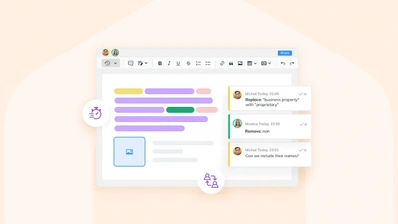The shape of things to come: student information systems edition

We’re a full third of a year into the COVID-19 pandemic, and academic institutions are starting to get a good idea of what remote learning will look like in the long term. New virtual classroom solutions are being established, and students the world over are already getting used to them. If this is how schools are going to conduct business from here on out, then a long-term strategy needs to be decided upon. If it’s not already on your summer to-do list — then, it should be. And if it is already, then you’ve come to the write right place.
It’s important to remember why optimizing your student information system is so crucial. It helps manage student data, both public and private, thus you can also think of it as a student management system. This information helps students and others in academia track progress and check attendance, billing, financial aid status, enrollment status, and various dates of admission they should keep track of. Between this and things more relevant in a day-to-day setting like holding info on class schedules, grades, and test results, student information systems exist to help guide students along. Student records in general are at stake within this system.
Modern systems are web based and offer various cloud-based benefits of today’s digital age. This is why having a good interface is important alongside having every educational department have a say or role within this communication platform. They can be used to generate efficient communication across all levels and integration for new students alongside continuing education to progress.
A student information system’s chief goal is to aid school communication of news and announcements between students, teachers, parents, faculty, and staff. Effective school communication is a must in today’s digital age where everyone from k-12 to higher education (university) as academia professionals these days expects to be on top of things regarding tracking student progress. A good student information system adds to schools’ efficiency.
Below, we establish three main pillars of school communication: web presence, communication, and honesty and transparency. After explaining what the pillars are, we provide some friendly pointers and approaches for maintaining them. We argue that real-time collaboration with rich-text editing features can aid school communication efforts. CKEditor looks at the world and sees how these technologies can help produce content that’s true to the intent of communications teams everywhere.
Our findings do not make a strategy in itself, but you’ll be able to see what student information systems need to do to make the long-term, sustainable, remote operation of a school possible. They should be combined with good school management systems and tools to make remote study fully successful if being present on campus is not always an option or ideal.
# Web presence
A solid public relations strategy is key to helping an educational institution navigate a crisis. A school’s homepage is central to that strategy. It’s the go-to source for people to get information on school operations. Unfortunately, the bulk of a school’s faculty isn’t well educated in HTML, code, or web design. A shift in perspective of what web presence means can help come up with new approaches to maintaining it. “Your school website is not a technology project. It is a communications project,” writes Bonnie Leedt, CEO of School Webmasters. “If not done well, it can do more harm than good for your public relations, branding, and reputation. It shows the public what you believe in, or possibly what you don’t.” For faculty, staff, students and parents, the content matters more than the code.
To communicate clearly, DON’T underestimate the importance of formatting text. As the saying goes, “the medium is the message.” That also applies to large amounts of text. In sending out news, it is not pleasant for the receiver to be hit with a wall of text with a uniform font and size. A lack of formatting makes reading tedious and makes readers less likely to take your news briefs seriously. It’s a problem that you can avoid with a little tweaking of the text.
How? Simple. DO format your text cleanly. Having a rich text editor built into student information systems can help. Staff and faculty in charge of producing, moderating and monitoring school content can choose from a wide family of fonts, adjust size and color, and use proper headings. As such, nobody has to be a designer to organize information and make a school’s content more presentable. Clarity of communication is a way a student information system expresses a school’s visual identity.
Prospective students today look for schools and universities to have a web presence at an institutional level and not just based on department or teacher. They are used to make payments through online portals and are used to managing their progress through the use of web portals. We web-based form of education is the key to modern learning and allow for flexibility in remote or virtual learning as well.
# Communicating news
Sometimes, the message is also the message. There are certain external things that school leadership decides to let parents, students, and the general public know. Certain pieces of information, then, are for internal use among faculty. In any event, student information systems can disseminate info through mailing lists, newsletters, social media, and portals. How can a student information system help administrators see communication as an essential leadership capability rather than a set of techniques?
Let’s focus on school community newsletters, which are indispensable tools to inform, promote, and educate. Governmental bodies such as the New Zealand Ministry of Education advise on how such newsletters should be composed and what sort of information should be included to the benefits of its audience. Organization is chief among them, and the use of templates is key to text organization. To comply with these guidelines, a good student information system includes features like text alignment and auto-formatting to speed up the process of creating templates. Also, our spell and grammar checking features help fill a template with clean language, all to use when time is of the essence.
Nobody likes breaking developments and not being able to get information about them up-to-date, so DON’T wait until disaster strikes to work on your school’s communication. openSIS is a student information system that enables email blasts to make announcements to pre-selected individuals and groups, as well as message tracking. With improved communication features like text alignment, autoformatting, and spell/grammar check, news can get out to the public that much quicker.
With that said, it’s a no-brainer: DO have a strategy in place. The ability to make templates with speed can lead to an improved style guide, wherein lengths of paragraphs, styles of address, and use of school- or locally-specific terms can be set in stone. Taken together (along with some good proofreading!), these are the building blocks of a school’s communication strategy. A student information system should help deploy that strategy.
# Honesty and transparency
Schools rely on modern and efficient technology to communicate with students, parents, faculty, and staff. This in turn helps guide student progress skyward. At the end of the day, though, it’s as much about the technology as what you use it for. A school’s communications department should always ensure its content reflects key messages, values and beliefs. If we return to the idea of creating a style guide — and hence the concept of shaping internal policy — there is a lot at stake.
DON’T keep faculty in the dark about decisions. As with any workplace, there are internal politics that can greatly affect a school’s community if faculty and staff are left out of decision-making processes. These decisions could be an alteration of sick leave policy in the wake of the ongoing pandemic, or even drawing up a new school charter that reimagines how a school will function in the wake of lockdown measures. Student information systems such as the aforementioned openSIS and Classe365 contain the ability to create internal portals for staff communication. If a technology already exists, there’s an evident need to serve. So…
DO encourage open, honest communication about internal policy and the reporting of happenings accurately. All the better if it can take place within drafts of policy documents written with the aid of student information system software. Its writing tools would do well to include comments and track changes features. The former would enable staff and faculty to discuss passages and even details at the point of appearance in documents, and the latter would promote collaboration in turning out important documents. Permissions can be set to let certain members comment without being able to edit based on the delegation of responsibility.
Being able to efficiently communicate with students and between key staff at an educational setting will go a long way to modernize the way people teach and learn going forward. A student information management system or just a student information system can go a long way in this regard.
# In conclusion
Student information systems have arrived at a point where their communication needs to be as crisp as ever, so the right technology is needed. for the job. Schools need to look for software that can help them achieve their goals and build their reputation. Communication is among those goals. This is because faulty communication could lead to uncertainty, a potential loss of support, and undermining the school. Good communication helps schools data management, assignment progress, keep track of student-related happenings, and the ability for teachers and faculty to interact with students.
Student information systems with support for rich-text editing and collaboration features will help sharpen communication and develop schools management software to be more streamlined and flexible as well as add to the overall educational efficiency. Everyone benefits from teachers and administrators to students themselves. Having insight into student activities and day-to-day activities can make a student that much more successful in the long term.
See related articles:
- What are virtual classrooms? Virtual classroom software - CKEditor
- What is WYSIWYG?
- Knowledge management and capturing the ideas of your talent
- Content publishing during Covid-19
- 5 ways SaaS companies can benefit from collaborative editing with CKEditor 5
- Agile project management - history, benefits and advantages of use
- Knowledge management tools - the top 5 on the market according to CKEditor


